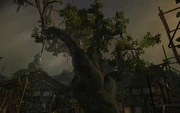- Mostly the old ways are gone. Each generation forgets a little more of the old tongue, a little more of the traditions. And the few things we keep become simple habits, the meaning long since faded.
- So it is with the vhenadahl, the tree of the people. Every alienage has one, I'm told. Or they used to. When I was a little girl, my mother told me the tree was a symbol of Arlathan, but not even she knew more. Keeping the vhenadahl is just a habit, now. Many cities have let theirs wither and die, then chopped them up for firewood. No great loss.

The vhenadahl, or "tree of the People," is one of the major symbols of city elf culture, and one of the most visible landmarks of the alienages.
History
This massive vhenadahl, often an oak, rests in the center of most alienages, and serves as a symbol of Arlathan - the first elven homeland - with its strong roots deep in the earth and branches reaching ever for the sky.[2] These trees are often decorated vibrantly, their trunks bedecked and candles or small offerings left around them,[3] though the trees' upkeep has recently become more of a habit than a respected tradition. Indeed, some alienages have cut their vhenadahl down out of need or indifference, and no longer know or care what it represents.[4]
In the case of the Edgehall vhenadahl, it was cut down on the order of Arl Gell Landon after the elves there protested his treatment of them, and was finally replaced with a sapling offered by a Dalish clan. The sapling was confiscated by Arl Gedon, and the Dalsih threatened to invade Edgehall if the sapling wasn't returned. A city elf attempted to steal it back in the meantime, but in the end it was retrieved to the Alienage by Ser Aaron, who happen to be in Edgehall at the time. The new vhenadahl is protected by law, as decreed by King Alistair himself.[5]
Trivia
- The wood of the vhenadahl is sometimes prized for making mallets for a game called "wallop"[6], and sometimes for weapons (vhenadahl is a Tier 8 material for weapons in Dragon Age: Origins - Awakening).
- Alternatively, in the Denerim alienage, residents urinate on the vhenadahl for reasons known only to themselves.[7]
- According to Sera, the city elves in Denerim "pray at" the vhenadahl.
- A text on the carved tablet found in the Temple of Mythal appears to equate the loss of eternity and the "tree of the People" and laments the ensuing inability to travel the Fade.[8]
- A unique ring, the Carved Ring of the Vhenadahl, can be found in the Primeval Thaig despite being obviously quite far from any alienage
- A "peace tree" is mentioned in connection with Skyhold. As a living tree it was once a symbol of truce between two forgotten factions. Before the first stones of Skyhold's foundations were laid, the tree was cut down, slabbed, and polished to serve as a massive war table.[9]
- In the The Darkspawn Chronicles, during the quest Raze the Alienage, the Archdemon puts special emphasis in prioritizing the destruction of the vhenadahl of Denerim's Alienage.
References
- ↑ Codex entry: Vhenadahl: The Tree of the People.
- ↑ The History of the Elves. BioWare wiki.
- ↑ The elves of the Kirkwall Alienage in Dragon Age II have painted their vhenadahl and lit candles around it, while the Val Royeaux elves decorate their vhenadahl with ribbons and leave small pieces of brightly-colored cloth at the base of theirs. Dragon Age: The Masked Empire, pg. 85.
- ↑ Codex entry: Vhenadahl: The Tree of the People.
- ↑ Dragon Age: Knight Errant, number 1.
- ↑ Per Gamlen during the quest Gamlen's Greatest Treasure.
- ↑ According to Zevran Arainai if brought into the alienage in Dragon Age: Origins.
- ↑ Where Willows Wail from Dragon Age: The World of Thedas Volume 2, p.201
- ↑ The Art of Dragon Age: Inquisition
| ||||||||||||||||||
